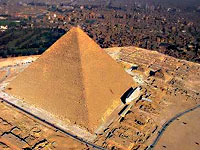

The Great Pyramid of Giza (also called the Pyramid of Khufu and the Pyramid of Cheops) is the oldest and largest of the three pyramids in the Giza Necropoli, Egypt. It is the oldest of the Seven Wonders of the Ancient World, and the only one to remain largely intact. It is believed the pyramid was built as a tomb for fourth dynasty Egyptian Pharaoh Khufu (Cheops in Greek) and constructed over a 20-year period concluding around 2560 BC.The Great Pyramid was the tallest man-made structure in the world for over 3,800 years. There have been varying scientific and alternative theories about the Great Pyramid's construction techniques. Most accepted construction hypotheses are based on the idea that it was built by moving huge stones from a quarry and dragging and lifting them into place.
The Great Pyramid consists of an estimated 2.3 million limestone blocks with most believed to have been transported from nearby quarries. The Tura limestone used for the casing was quarried across the river. The largest granite stones in the pyramid, found in the "King's" chamber, weigh 25 to 80 tonnes and were transported from Aswan, more than 500 miles away. Traditionally, ancient Egyptians cut stone blocks by hammering wooden wedges into the stone which were then soaked with water. As the water was absorbed, the wedges expanded, causing the rock to crack. Once they were cut, they were carried by boat either up or down the Nile River to the pyramid. At completion, the Great Pyramid was surfaced by white "casing stones" - slant-faced, but flat-topped, blocks of highly polished white limestone. These were carefully cut to what is approximately a face slope with a seked of 5½ palms to give the required dimensions. Visibly, all that remains is the underlying stepped core structure seen today.
There are three known chambers inside the Great Pyramid. The lowest chamber is cut into the bedrock upon which the pyramid was built and was unfinished. The Queen's Chamber and King's Chamber are higher up within the pyramid structure. The Great Pyramid of Giza is the only pyramid in Egypt known to contain both ascending and descending passages. The main part of the Giza complex is a setting of buildings that included two mortuary temples in honor of Khufu (one close to the pyramid and one near the Nile), three smaller pyramids for Khufu's wives, an even smaller "satellite" pyramid, a raised causeway connecting the two temples, and small mastaba tombs surrounding the pyramid for nobles.
Several mystery shafts extend from the king's and queen's chambers. Neither airshafts (they were sealed) nor hallways (they are too narrow), they may have been designed to allow Khufu to travel to the stars in his afterlife. A blocked shaft from the queen's chamber was penetrated in 2002. Archaeologists discovered another stone blocking their way.
The interior of the pyramids included narrow corridors and hidden chambers in an unsuccessful attempt to foil grave robbers. Although modern archeologists have found some great treasures among the ruins, they believe most of what the pyramids once contained was looted within 250 years of their completion.
All the pyramids can be seen from thirty miles from Giza itself. The site is truly spectacular. The walls are covered in fabulously incised hieroglyphics. From the outside, if you are standing right next to the pyramid, you will not be able to see the top. It is a pity to see that the Great Pyramids are in danger because of its neighbor, the ever-growing metropolitan city of Cairo. The pollution is causing the pyramids and the Great Sphinx to slowly deteriorate.
It is now illegal to climb the pyramid, but you can go inside. A separate ticket is required to enter each pyramid. Only 300 tickets are sold each day, 150 in the morning and another 150 in the afternoon, after 1pm. Tickets on sale at 8:00am & 1:00pm. No photography is allowed inside the pyramid.

Try out the other sections